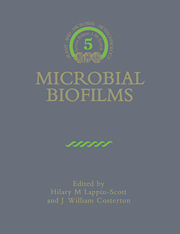Book contents
- Frontmatter
- Contents
- List of Contributors
- Series Preface
- Introduction to Microbial Biofilms
- Part I Structure, Physiology and Ecology of Biofilms
- 1 Growth of Microorganisms on Surfaces
- 2 Dynamics of Bacterial Biofilm Formation
- 3 Cultivation and Study of Biofilm Communities
- 4 Genetic Responses of Bacteria at Surfaces
- 5 Biochemical Reactions and the Establishment of Gradients within Biofilms
- 6 Mechanisms of the Protection of Bacterial Biofilms from Antimicrobial Agents
- Part II Biofilms and Inert Surfaces
- Part III Biofilms on the Surfaces of Living Cells
- Index
5 - Biochemical Reactions and the Establishment of Gradients within Biofilms
Published online by Cambridge University Press: 24 November 2009
- Frontmatter
- Contents
- List of Contributors
- Series Preface
- Introduction to Microbial Biofilms
- Part I Structure, Physiology and Ecology of Biofilms
- 1 Growth of Microorganisms on Surfaces
- 2 Dynamics of Bacterial Biofilm Formation
- 3 Cultivation and Study of Biofilm Communities
- 4 Genetic Responses of Bacteria at Surfaces
- 5 Biochemical Reactions and the Establishment of Gradients within Biofilms
- 6 Mechanisms of the Protection of Bacterial Biofilms from Antimicrobial Agents
- Part II Biofilms and Inert Surfaces
- Part III Biofilms on the Surfaces of Living Cells
- Index
Summary
Biofilms and the physiology of microorganisms within them
Microbiologists have been accustomed until recently to think of microbes as homogeneous cultures grown in well mixed containers ranging in size from shake flasks to large industrial continuously stirred tank reactors. The investigative tool of choice has been the chemostat which is homogeneous not only in spatial terms but, when operating at a steady state, in time as well.
The only other traditional badge of the microbiologist is the colony. This is much more representative of the natural ecosystem since it is a microbiological aggregate dominated by diffusion gradients. For example oxygen only penetrates about 25–35 μm into a rapidly growing young colony (Wimpenny & Coombs 1983).
Microbial ecosystems are generally spatially heterogeneous implying that solutes move down concentration gradients between sources and sinks. Such gradients are found over a huge range of dimensions, from nanometres for pH gradients around clay lattices to hundreds of metres in the case of oxygen gradients in the Black Sea. These scale factors are illustrated, generally for oxygen, in Table 5.1.
Biofilms have been defined in many different ways; however, perhaps the simplest view is that it is a microbial aggregate that forms at phase interfaces. The most common biofilms appear at solid–water interfaces epitomized by the epilithon that forms on submerged rocks in streams and other water bodies. Generally such biofilm development follows a fairly standard life history. Clean surfaces become coated with a conditioning film consisting of organic molecules, for example proteins or polysaccharides. A little later individual cells attach to the surface, first loosely and reversibly and then firmly and irreversibly.
- Type
- Chapter
- Information
- Microbial Biofilms , pp. 99 - 117Publisher: Cambridge University PressPrint publication year: 1995
- 13
- Cited by

